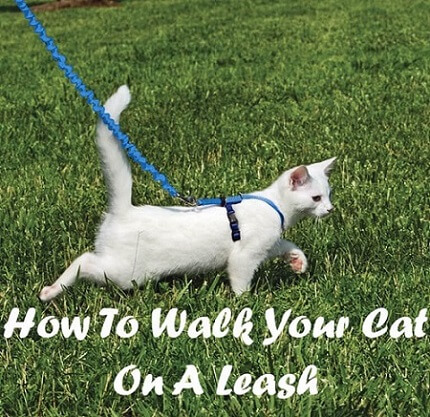How To Walk Your Cat On A Leash?
This page contains affiliate links. We may earn money or products from the companies mentioned in this post through our independently chosen links, which earn us a commission. Learn More

While almost every dog owner walks their dog, few cat owners even consider walking their cats. However, cats can be trained to walk on a leash outdoors. In fact, there are collars, harnesses, and leashes specially designed just for cats. Walking your cat on a leash starts with the right equipment and a little patience.
Unlike dog collars, cat collars are not created so that they can be used with a cat leash. Cat collars are usually created with a break away safety feature to prevent strangling. Instead, collars are used for other reasons like ID tags or accessories. Some believe a cat with a bell on its collar will warn birds of an approach.
Choices
Cat harnesses are designed to stay securely on your cat, even when the leash is attached. You can buy a simple nylon harness for your cat or you can find more deluxe models that look more like padded vests or jackets. The leash attachment is toward the middle on these harnesses rather than at the neck, which is much safer and less stressful for your kitty. As long as the harness is completely adjustable, it should work for most size cats.
Cat leashes can be standard leashes or retractable models. Whichever type of leash you choose, be sure that it is lightweight enough to allow your cat to move easily under its weight. Retractable leashes are ideal for people who want to allow their cats to explore their surroundings in a park or other traffic safe area, but want to keep cats close by when they are walking to and from their homes.
Training
Before you even think about stepping outside you should get your cat used to wearing the harness. Put the harness on your cat, making sure it’s snug but not too tight. As soon as the harness is on, before letting go, give her a treat. If she takes a step in the harness, give her a treat, praise her and pat her on the head. Repeat the treating and praising while she continues to move about in her harness. If your cat drops to the ground, wait to see if she moves and give a treat if she does. If she seems frozen in place, or if her way of freaking out is to run and hide under something, remove the harness and give a treat as a peace offering. Try leaving the harness near your cat’s food bowl at mealtime or near her favorite sleeping spot to get her used to seeing it in places she associates with good things. Try the process all over again in a few days.
After a few days of successful harness training, add the leash. Be sure that you do not apply any pressure. Once your cat is used to the leash, you can pick her up and teach her that you will be on the other end of the leash. Gently apply pressure to the leash and call your cat to you. Praise her when she responds. Eventually, she will become used to following you when she is on her leash.
To familiarize your cat with walking around on a leash, start slow, take baby steps forward and expect setbacks. Cats do not do well with negative correction, so treating them like a dog on a leash will not be effective. Instead, praise your cat when he does what you want and ignore her when she does not. Although you can teach your cat to tolerate a leash, don’t expect her to consistently heel on command.
Conclusion
The easiest way to teach your cat to use a leash is to start when she is a kitten around eight to ten weeks old. Once your cat learns to walk on a leash she can enjoy the great outdoors safely.



